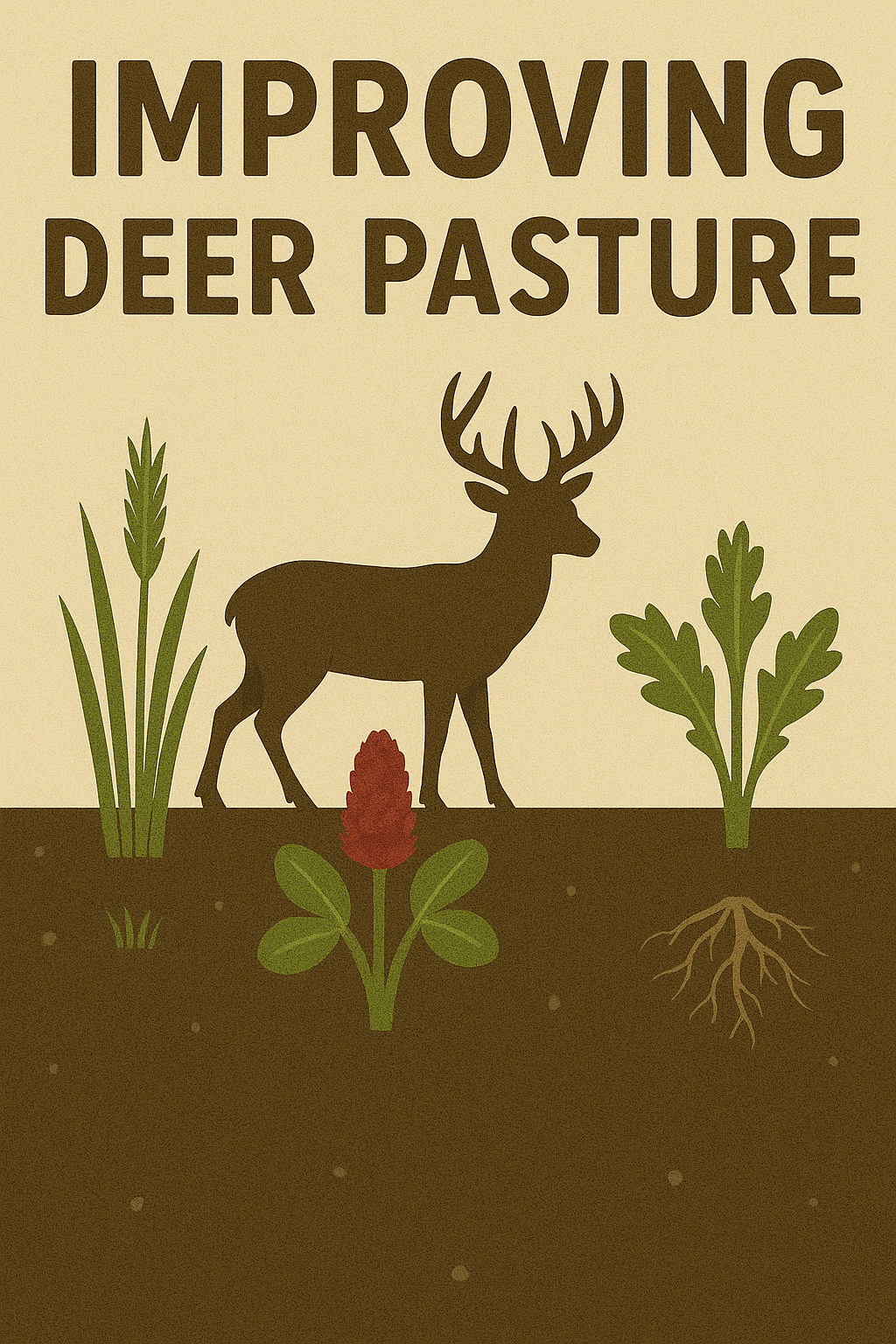
Improving Deer Pasture
Deer farming presents unique challenges when it comes to pasture management. Deer are selective grazers and require high-quality, palatable forage to support their growth, velvet production, and overall health. Building a diverse and productive deer pasture requires careful consideration of species selection, as well as tailoring the mix to the specific needs of deer and the environmental conditions of the farm.
Key Components of a Successful Deer Pasture
-
Wide Variety of Grasses:
-
Grasses form the foundation of any deer pasture, providing bulk forage and consistent dry matter production. Avoid using grasses with endophyte strains, as these can negatively impact deer health and velvet quality.
-
Recommended Grasses: Perennial ryegrass (endophyte-free), hybrid ryegrass, timothy, and cocksfoot.
-
Herbs:
-
Deep-rooted herbs like plantain and chicory are essential for deer pastures. They are highly palatable, provide essential minerals, and remain productive during dry periods.
-
Plantain: A versatile herb that reduces nitrogen leaching and offers excellent forage quality.
-
Chicory: High in minerals like zinc and selenium, which are important for antler growth and overall health.
-
Legumes:
-
Legumes enhance soil fertility by fixing nitrogen, reducing the need for synthetic fertilizers, and offering protein-rich forage.
-
White Clover: A reliable choice for grazing systems.
-
Red Clover: Provides high yields and is particularly productive in summer.
-
Lucerne (Alfalfa): Suitable for free-draining soils, offering high-quality forage and drought resilience.
-
Brassicas:
-
Forage brassicas like kale and turnips are excellent for boosting forage availability during winter or dry seasons. They offer high-energy feed and are readily grazed by deer.
-
Cereals:
-
Incorporating cereals like oats or barley in your mix can provide a quick-growing, high-energy feed option, particularly during establishment or transitional periods.
Case Study: Dugald Hamilton’s Client – A 22-Species Deer Mix
We recently worked with a client of Dugald Hamilton to develop a deer-specific pasture mix. The 22-species mix included a combination of grasses, legumes, herbs, brassicas, and cereals, creating a truly diverse and balanced forage system.
Key Highlights:
-
Impressive Dry Matter Production: The mix thrived even during the heat of summer, maintaining high productivity and providing consistent feed when it was most needed.
-
Complete Palatability: Unlike many pastures, where deer tend to selectively graze only their preferred species, this mix was completely consumed by the deer. Every species included was palatable, ensuring no wastage.
-
Heat Resilience: The deep-rooted herbs and diverse species helped the pasture handle extreme summer conditions, ensuring forage availability even during dry spells.
This case demonstrates how a carefully crafted mix can address the unique challenges of deer farming while delivering exceptional results.
Avoiding Endophyte Grasses for Deer Velvet Production
One critical consideration when designing deer pastures is avoiding grasses with endophytes. Endophytes are fungi that live within some grass varieties, providing benefits like pest resistance and drought tolerance. However, the alkaloids produced by these endophytes can negatively affect deer, particularly their velvet production and overall health.
At Pastoral Improvements, we prioritize endophyte-free grasses in our deer mixes to ensure the health and performance of your herd.
Tips for Establishing and Managing Deer Pastures
-
Custom Seed Mixes:
-
Work with experts to develop a mix tailored to your farm’s climate, soil type, and production goals. A diverse mix ensures year-round forage availability and meets the nutritional needs of deer.
-
Sowing and Establishment:
-
Sow in autumn or spring to ensure optimal establishment conditions. Drill or broadcast seeds, ensuring good seed-to-soil contact.
-
Grazing Management:
-
Implement rotational grazing to allow plants to recover and prevent overgrazing. Grazing management is especially important during establishment.
-
Monitor Pasture Performance:
-
Keep track of pasture productivity, weed pressure, and grazing patterns. Adjust the mix or management practices as needed to optimize results.
The Benefits of a Diverse Deer Pasture
-
Balanced Nutrition: A mix of grasses, legumes, herbs, and brassicas provides a wide range of nutrients essential for deer health, growth, and velvet production.
-
Resilience: Diverse species ensure pasture productivity under various weather conditions, from dry summers to cold winters.
-
Reduced Input Costs: Legumes fix nitrogen, reducing the need for synthetic fertilizers, while deep-rooted species improve soil structure and reduce the risk of compaction.
-
Enhanced Palatability: Deer prefer a varied diet, and a diverse pasture mix ensures they consume more of what’s grown, reducing waste and improving feed efficiency.
